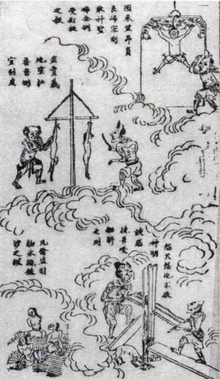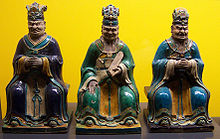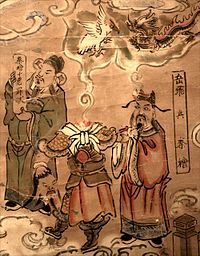- Diyu
-
Diyu Illustration from the Jade Record: Sinners are being tortured in the sixth court of hell by hammering metal spikes into the body; skinning alive; sawing body in half; and having to kneel on metal filings. Chinese name Traditional Chinese 地獄 Simplified Chinese 地狱 Literal meaning earth prison Transcriptions Gan - Romanization thì ngo̍k Mandarin - Hanyu Pinyin Dìyù - Wade–Giles Ti-yü Cantonese (Yue) - Jyutping dei6 juk6 Japanese name Kanji 地獄 Transcriptions - Romaji Jigoku Korean name Hangul 지옥 Literal meaning hell, underworld Transcriptions - Revised
Romanizationjiok Vietnamese name Quốc ngữ địa ngục Diyu (Sanskrit: नरक "Naraka") is the realm of the dead or "hell" in Chinese mythology. It is loosely based on a combination of the Buddhist concept of Naraka, traditional Chinese beliefs about the afterlife and a variety of popular expansions and re-interpretations of these two traditions.
Diyu is typically depicted as an underground maze with various levels and chambers, to which souls are taken after death to atone for the sins they committed when they were alive. The exact number of levels in Diyu and their associated deities differ between Buddhist and Taoist interpretations. Some speak of three to four "courts"; others mention "Ten Courts of Hell", each of which is ruled by a judge (collectively known as the Ten Yama Kings); other Chinese legends speak of eighteen levels of Hell. Each court deals with a different aspect of atonement and different punishments; most legends claim that sinners are subjected to gruesome tortures until their "deaths", after which they are restored to their original state and the torture repeated.
Contents
Conceptions of Diyu
According to ideas from Taoism,[1][2] Buddhism[3][4][5] and traditional Chinese folk religion, Diyu is a purgatory that serves to punish and renew spirits in preparation for reincarnation into their next life. Many deities, whose names and purposes are the subject of conflicting accounts, are associated with Diyu.
Some early Chinese cultures speak of people going to Mount Tai, Jiuyuan, Jiuquan or Fengdu after death.[6][7][8] In the present-day, Fengdu and the temples on Mount Tai have been rebuilt into tourist attractions, incorporating artistic depictions of hell and the afterlife.[9][10] Some controversial folk religion planchette writings, such as Journeys to the Under-World, say that new hells with new punishments are created as the world changes and there is also a city of Innocent Deaths (枉死城).[11][12][13] Some claimed there are other facilities.[14][15]
Ten Courts of Hell
The concept of the "Ten Courts of Hell" began after Chinese folk religions were influenced by Buddhism. In Chinese mythology, the Jade Emperor put King Yama in charge of overseeing the affairs of Diyu. In fact some were cold hells, other were dark and yet others were miscellaneous hells. There were 12,800 hells located under the earth, eight dark hells, eight cold ones and 84,000 miscellaneous ones located at the edge of the universe. All people will go to hell but the length of stay will vary depending on the severity of the crime and all will eventually be reborn. In the meantime souls will pass from stage to stage all at the decision of King Yama. King Yama also reduced the number hells down to ten. King Yama later divided Diyu into ten courts, each overseen by a "Yama King", while King Yama remained the sovereign ruler of hell. The Ten Yama Kings are:
- Jiang, King of Qinguang (秦廣王蔣), believed to be Jiang Ziwen (蔣子文) of the Eastern Han Dynasty
- Li, King of Chujiang (楚江王歷)
- Yu, King of Songdi (宋帝王余)
- Lü, King of Wuguan (五官王呂)
- Bao, King of Yama (閻羅王包), believed to be Bao Zheng of the Northern Song Dynasty
- Bi, King of Biancheng (卞城王畢)
- Dong, King of Taishan (泰山王董), believed to be Dong Ji (董極) of the Later Han Dynasty
- Huang, King of Dushi (都市王黃), believed to be Huang Sile (黃思樂) of the Five Dynasties period
- Lu, King of Pingdeng (平等王陸)
- Xue, King of Zhuanlun (轉輪王薛)
Eighteen levels of hell
The concept of the eighteen hells started in the Tang Dynasty. The Buddhist text Wen Diyu Jing (問地獄經) mentioned 134 worlds of hell but was simplified to eighteen levels of hell for convenience. The following is a list of common punishments and tortures in the eighteen levels of hell:
- Mountain of knives – sinners are made to shed blood by climbing a mountain with sharp blades sticking out. Some depictions show offenders climbing trees with knives instead of mountains.
- Cauldron torture – sinners are fried in oil cauldrons. Some depictions show offenders being steamed instead of being fried.
- Dismemberment – sinners' bodies are dismembered by various means, including: sawing, carving, slicing into half, mashing/pounding into pulp, crushed by heavy rocks/boulders, being run over by vehicles
- Grinding torture – sinners are put into a grinding machine and ground into a bloody pulp
- Tortures involving fire
- Burning – sinners are set aflame/cast into fiery infernos
- Paolao torture – sinners are stripped naked and made to climb a large metal cylinder, with a fire lit at its base.
- Boiling liquid torture – sinners have a boiling liquid forced down their throats
- Tortures involving removal of body parts/organs
- Tongue-ripping
- Eye-gouging
- Heart-digging
- Disembowelment – sinners have their internal organs dug out
- Skinning
- Slicing off fingers/toes
- World of ice – sinners are frozen in ice. Some depictions show unclothed sinners suffering from frostbite in an icy world. The bodies might fall apart or break into pieces.
- Scales and hooks torture – sinners have hooks pierced into their bodies and hung upside down. Some depictions show sinners having nails hammered into their bodies.
- Pool of blood – sinners are cast into a pool of blood and suffer bloody deaths, such as blood spilling from all body orifices
- Tortures involving animals – sinners are trampled by cattle, gored by animals with horns/tusks, mauled/dismembered/eaten by predators, stung/bitten by poisonous species etc.
- Chamber of Avici – the period of suffering in this chamber is the longest and it is reserved for sinners who have committed heinous crimes, including the Five Grave Offences
Some literature refers to eighteen types of hells or to eighteen hells for each type of punishment. Some religious or literature books say that wrongdoers who were not punished when they were alive are punished in the hells after death.[16][17][18][19][20][21][22][23][24] [25][26] [27][28][29]
Alternate names for hell
Among the more common Chinese names for the Underworld are:
- 地獄 – dìyù the underworld prison
- 地府 – dìfŭ the underworld mansion
- 黃泉 – huángquán the yellow spring (meaning the origin/source of life and death, possibly a reference to the Yellow River or yomi)
- 陰間 – yīnjiān the netherworld (cf. Yin and yang)
- 陰府 – yīnfŭ the shady mansion
- 陰司 – yīnsī the shady office
- 森羅殿 – sēnluó diàn the court of Sinluo
- 閻羅殿 – yánluó diàn the court of Yanluo
- 九泉 – jiŭquán the nine springs (origin/source)
- 重泉 – chóngquán the repeating spring (origin/source)
- 泉路 – quánlù the spring road
- 幽冥 – yōumíng the serene darkness
- 幽壤 – yōurăng the serene land
- 火炕 – huŏkàng the fire pit
- 九幽 – jiŭyōu the nine serenities
- 九原 – jiŭyuán the nine origins
- 冥府 – míngfŭ the dark mansion
- 阿鼻 – ābí (pinyin), a Buddhist term, from Sanskrit Avīci, the hell of uninterrupted torture, last and deepest of eight hot hells
- 足跟 – zúgēn the heel of the foot, also means hells
- 酆都城 – Fēngdū Chéng, name of a city imagined to contain an entrance to Diyu
Other terminology related to hell includes:
- 奈何橋 – 'the bridge of helplessness', the only way across the River Styx
- 望鄉臺 – 'the home viewing pavilion', allows the souls of the dead to observe their families from the underworld.
- 油鍋 – the deep frying wok, one of the tortures in hell.
- 三塗 – the three tortures, burning by fire (Budd. 火塗), chopping by knife (Budd. 刀塗), tearing apart by beasts (Budd. 血塗, spilling of blood).
See also
- Bon Festival
- Ghost Festival
- Hell Bank Notes
- Journeys to the Under-World
- Ksitigarbha
- Maudgalyayana
- Meng Po
- Ox-Head and Horse-Face
- Naraka (Buddhism)
- Yama (Buddhism and Chinese mythology)
Notes
- ^ 北京的寺廟-4. Tw.myblog.yahoo.com (2007年07月25日). Retrieved on 2011年11月14日.
- ^ 上鍊經第十. Jnk.org.tw. Retrieved on 2011年11月14日.
- ^ 诸经佛说地狱集要. Read.goodweb.cn. Retrieved on 2011年11月14日.
- ^ 汉魏六朝佛教之“地狱”说(上). Wuys.com (2006年12月22日). Retrieved on 2011年11月14日.
- ^ 汉魏六朝佛教之“地狱”说(下). Wuys.com (2006年12月22日). Retrieved on 2011年11月14日.
- ^ 華雨集第四冊05. Yinshun.org.tw. Retrieved on 2011年11月14日.
- ^ 泰山崇拜与东岳泰山神的形成. Taishanly.com (2008年03月03日). Retrieved on 2011年11月14日.
- ^ 山不在高,有仙則名──論泰山、上古神山與生死[dead link]
- ^ 蒿里山[dead link]
- ^ 有“十八层地狱”的宫观——东岳庙. Mcprc.gov.cn (2009年04月30日). Retrieved on 2011年11月14日.
- ^ 觀靈實錄-枉死城系列報導PDF電子書. Wugin.com. Retrieved on 2011年11月14日.
- ^ 枉死城遊記
- ^ 三. 枉死城亡魂戒改. Tienton.myweb.hinet.net. Retrieved on 2011年11月14日.
- ^ 牽亡魂-國家之窗. Senwanture.com. Retrieved on 2011年11月14日.
- ^ 《最新落陰相褒歌》內容概述[dead link]
- ^ 勿闖鬼門關
- ^ 薜福成. 庸盦筆記
- ^ 地獄篇. Tw.myblog.yahoo.com. Retrieved on 2011年11月14日.
- ^ D因果故事新輯7
- ^ 瀕死體驗(新). Xn--1qq22qc0dpvm9wk.net. Retrieved on 2011年11月14日.
- ^ 泰国高僧定中看到地狱景象
- ^ 圆寂复魂师地狱游记(一). Blog.sina.com.cn (2010年03月11日). Retrieved on 2011年11月14日.
- ^ 因果轮回实录. Dizang.org. Retrieved on 2011年11月14日.
- ^ 天神記(四. B.biglobe.ne.jp. Retrieved on 2011年11月14日.
- ^ 敦煌写经·黃仕強傳. Hi.baidu.com (2011年11月08日). Retrieved on 2011年11月14日.
- ^ 九、唐太宗入冥記. Eywedu.com. Retrieved on 2011年11月14日.
- ^ 《風雲道者經典錄》叢書. Fwdict.com. Retrieved on 2011年11月14日.
- ^ 地獄見聞錄
- ^ 阴律无情官方网站. Blog.sina.com.cn. Retrieved on 2011年11月14日.
External links
- (Chinese) Xinhuanet 18 levels of hell article
- (Chinese) CBETA Chinese Electronic Tripitaka Buddhist version of 18 levels of hell (佛說十八泥犁經)
- (Chinese) History of Buddhist hell: (part 1, part 2)
- (Chinese) http://www.18hell.com
Chinese mythology Overview topics Major entities Creatures Bixie · Black Tortoise · Azure Dragon · White Tiger · Vermilion Bird · Qilin · Fenghuang · Huli jing · Chinese guardian lions · Píxiū · NiánPlaces Popular literary works Shan Hai Jing · Shi Yi Ji · The Peach Blossom Spring · Fengshen Bang · Legend of the White Snake · Strange Stories from a Chinese Studio · Journey to the West · In Search of the Supernatural · Zi Bu Yu · Tian Xian PeiUnderworlds 
Aztec mythology (Mictlan) · Buddhism (Naraka) · Chinese mythology (Diyu) · Persian mythology (Duzakh) · Christianity (Purgatory · Limbo · Hell) · Ancient Egyptian religion (Duat) · Germanic and Norse paganism (Hel · Niflheim) · Greek mythology (Hades · Tartarus) · Hinduism (Naraka · Patala) · Islam (Barzakh · Jahannam) · Jainism (Naraka) · Judaism (Gehenna · Sheol) · Shinto (Yomi) · Turkic-Mongolian (Erlik)

Afterlife locations Buddhism: Celtic: Christian: Heaven (Christianity) • Hell • Kingdom of God • Garden of Eden • Paradise • New Jerusalem • Pearly gatesAncient Egyptian: Germanic: Ancient Greek: Hindu: Indo-European: Islamic: Jewish: Mesoamerican: Mormon: Native American Persian Taoist Chinese Tian • DiyuJapanese Wicca Theosophy Related concepts: Millennialism • Utopianism • Great unity • Golden age • Arcadia • Avalon • The Guf • Well of Souls • Republic of Heaven • Existential planes • UnderworldCategories:- Buddhist mythology
- Chinese mythology
- Hell
- Taoist cosmology
- Afterlife places
Wikimedia Foundation. 2010.



